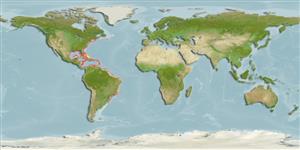Environment: milieu / climate zone / depth range / distribution range
Ekologi
laut batidemersal; kisaran kedalaman 247 - 274 m (Ref. 26912). Deep-water
Western Central Atlantic: New Jersey to Florida (USA), Cuba, Puerto Rico, and Venezuela; also in Suriname (Ref. 26912).
Size / Weight / umur
Maturity: Lm ? range ? - ? cm
Max length : 22.4 cm TL jantan/; (Ref. 115012); Berat maksimum terpublikasi: 56.90 g (Ref. 115012)
Life cycle and mating behavior
Maturities | Reproduksi, perkembang biakan | Spawnings | Egg(s) | Fecundities | Larva
Claro, R., 1994. Características generales de la ictiofauna. p. 55-70. In R. Claro (ed.) Ecología de los peces marinos de Cuba. Instituto de Oceanología Academia de Ciencias de Cuba and Centro de Investigaciones de Quintana Roo. (Ref. 26340)
Status IUCN Red List (Ref. 130435)
ancaman kepada manusia
Harmless
penggunaan manusia
Alat, peralatan
laporan khas
muat turun XML
Sumber internet
Estimates based on models
Preferred temperature (Ref.
123201): 4.3 - 19.5, mean 14.1 °C (based on 10 cells).
Phylogenetic diversity index (Ref.
82804): PD
50 = 0.5000 [Uniqueness, from 0.5 = low to 2.0 = high].
Bayesian length-weight: a=0.00380 (0.00230 - 0.00627), b=3.01 (2.87 - 3.15), in cm total length, based on LWR estimates for this species & Genus-body shape (Ref.
93245).
Trophic level (Ref.
69278): 3.5 ±0.3 se; based on size and trophs of closest relatives
Daya lenting (Ref.
120179): sedang, Waktu penggandaan populasi minimum 1.4 - 4.4 tahun (Preliminary K or Fecundity.).
Fishing Vulnerability (Ref.
59153): Low vulnerability (12 of 100).
